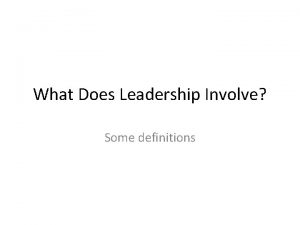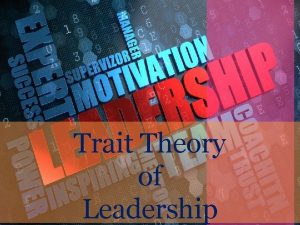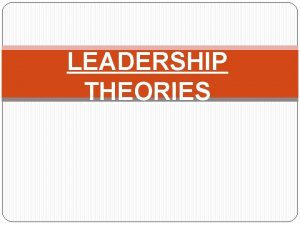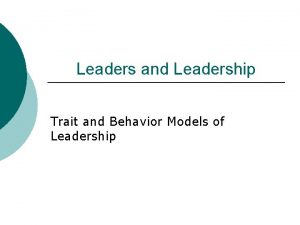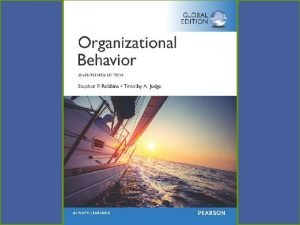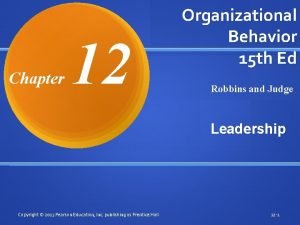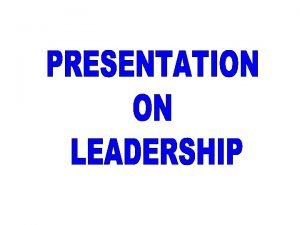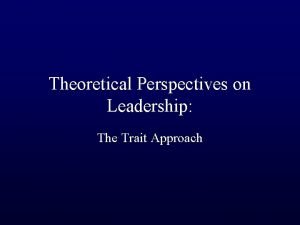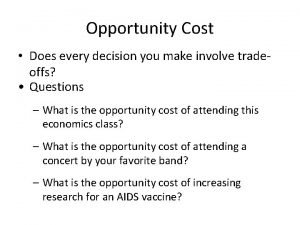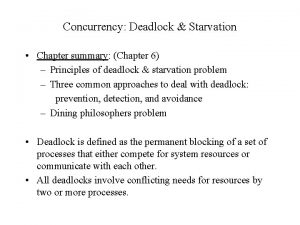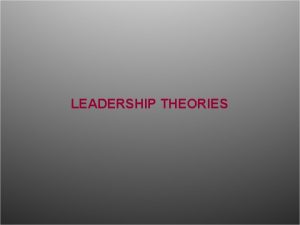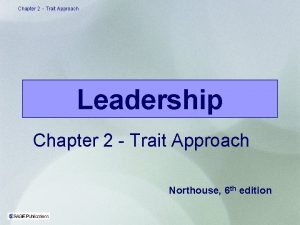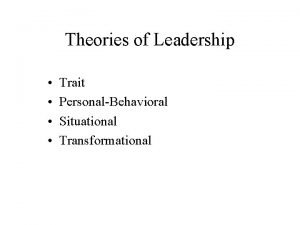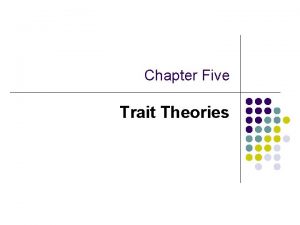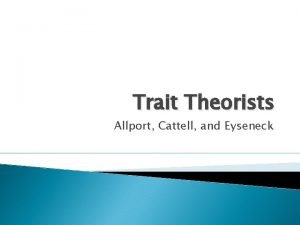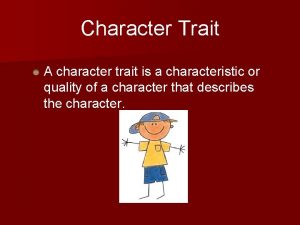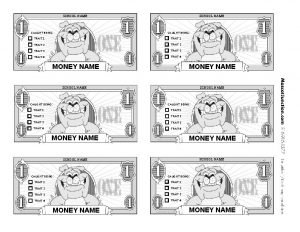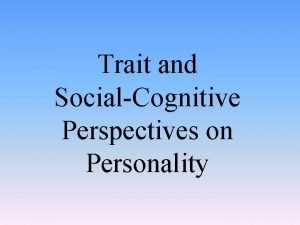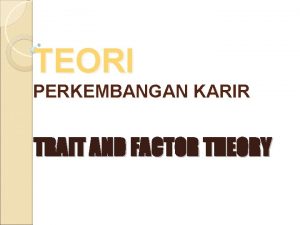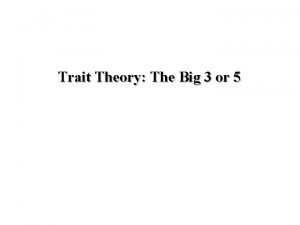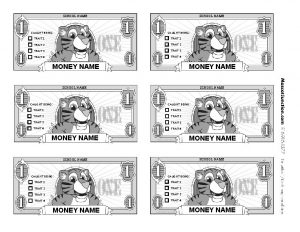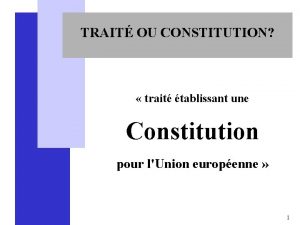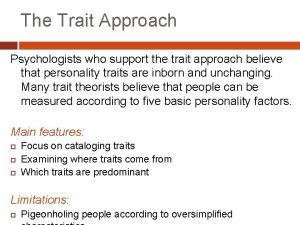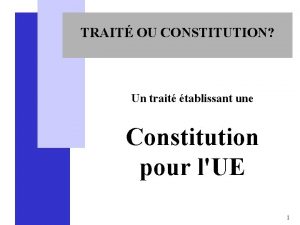17 Chapter What Does Leadership Involve n Trait





















- Slides: 21

17 Chapter What Does Leadership Involve? n Trait Behavioral Theories of Leadership n Situational Theories n From Transactional to Charismatic Leadership n Additional Perspectives on Leadership

17 -2 Leadership n Leadership influencing employees to voluntarily pursue organizational goals Mc. Graw-Hill © 2004 The Mc. Graw-Hill Companies, Inc. All rights reserved.

17 -3 Table 17 -1 Leaders Vs. Managers Leaders n n n n Innovate Develop Inspire Long-term view Ask what and why Originate Challenge the status quo Do the right thing Mc. Graw-Hill Managers n n n n Administer Maintain Control Short-term view Ask how and when Initiate Accept the status quo Do things right © 2004 The Mc. Graw-Hill Companies, Inc. All rights reserved.

17 -4 Historic Vs. Contemporary Trait Theories of Leadership Stogdill’s and Mann’s Findings n n n Intelligence Dominance Self-confidence Level of energy and activity Task-relevant knowledge Contemporary Trait Research n n n Mc. Graw-Hill people tend to perceive that someone is a leader when he or she exhibits traits associated with intelligence, masculinity, and dominance people want their leaders to be credible leaders are honest, forward-looking, inspiring, and competent © 2004 The Mc. Graw-Hill Companies, Inc. All rights reserved.

Behavioral Theories n Ohio State studies n Initiating structure n Consideration n Michigan State studies n Job-centered n Employee-centered

Consideration Four Leadership Styles Derived from the Ohio State Studies High Low Structure, High Consideration High Structure, High Consideration Low Structure, Low Consideration High Structure, Low Consideration Low 17 -8 Figure 17 -2 High Initiating Structure Mc. Graw-Hill © 2004 The Mc. Graw-Hill Companies, Inc. All rights reserved.

Contingency Theories n Also known as Situational Theories n The effectiveness of a style of leader behavior depends on the situation

17 -10 Figure 17 -4 Representation of Fiedler’s Contingency Model Situational Control High Control Situations Moderate Control Situations Low Control Situations Leader-member relations Good Poor Task Structure High Low Low Position Power Strong Weak Situation I II IV V VI VIII Optimal Leadership Styles Mc. Graw-Hill Task-motivated Leadership Relationship. Motivated Leadership Task. Motivated Leadership © 2004 The Mc. Graw-Hill Companies, Inc. All rights reserved.

17 -11 Figure 17 -5 House’s Revised Path-Goal Theory Employee Characteristics Leader Behaviors § Path-goal clarifying § Achievement oriented § Work facilitation § Supportive § Interaction facilitation § Group orienteddecision making § Representation and networking § Value based Mc. Graw-Hill § Locus of control § Task ability § Need for achievement § Experience § Need for clarity Leadership Effectiveness Environmental Factors § Task structure § Work group dynamics § Employee motivation § Employee satisfaction § Employee performance § Leader acceptance § Work-unit performance © 2004 The Mc. Graw-Hill Companies, Inc. All rights reserved.

Hersey and Blanchard’s Situational Leadership Theory n Appropriate leadership style is determined by follower readiness n Follower readiness is determined by followers’ ability and willingness to perform the task

17 -13 Transactional Vs. Charismatic Leadership n Transactional Leadership focuses on interpersonal interactions between managers and employees n n Mc. Graw-Hill Leader uses contingent rewards to motivate Leaders exert corrective action when subordinates fail to meet performance goals n Charismatic Leadership transforms employees to pursue organizational goals over self-interest n n Create, communicate, model vision Inspire employees to strive toward vision © 2004 The Mc. Graw-Hill Companies, Inc. All rights reserved.

17 -14 Figure 17 -7 Charismatic Model of Leadership Organizational culture Leader behavior § Adaptive § Leader establishes a vision § Leader establishes high performance expectations and displays confidence in him/herself and the collective ability to realize the vision Mc. Graw-Hill Effects on followers and work groups Outcomes § Increased intrinsic motivation, achievement orientation, and goal pursuit § Personal commitment to leader and vision § Increased identification with the leader and the collective interests of organizational members § Increased cohesion among workgroup members § Self-sacrificial behavior § Organizational commitment © 2004 The Mc. Graw-Hill Companies, Inc. All rights reserved.

17 -15 Figure 17 -7 cont. Charismatic Model of Leadership Organizational culture Mc. Graw-Hill Leader behavior Effects on followers and work groups § Leader models the desired values, traits, beliefs, and behaviors needed to realize the vision § Increased selfesteem, selfefficacy, and intrinsic interests in goal accomplishment § Task meaningfulness and satisfaction § Increased role modeling of charismatic leadership § Increased individual, group, and organizational performance Outcomes © 2004 The Mc. Graw-Hill Companies, Inc. All rights reserved.

17 -16 Research and Managerial Implications n Charismatic leadership is most likely to be effective when n The situation offers opportunities for “moral” involvement n Performance goals cannot be easily established or measured n Extrinsic rewards cannot be clearly linked to individual performance n There are few situational cues or constraints to guide behavior n Exceptional effort, behavior, sacrifices, and performance are required of both leader and follower Mc. Graw-Hill © 2004 The Mc. Graw-Hill Companies, Inc. All rights reserved.

The Leader-Member Exchange (LMX Model) n 17 -17 This model is based on the idea that one of two distinct types of leader-member exchange relationships evolve, and these exchanges are related to important work outcomes. In-group exchange: a partnership characterized by mutual trust, respect and liking n Out-group exchange: a partnership characterized by a lack of mutual trust, respect and liking n Mc. Graw-Hill © 2004 The Mc. Graw-Hill Companies, Inc. All rights reserved.

17 -19 Tips for Improving the Quality of LMX n n New employees should offer their loyalty, support, and cooperativeness to their manager If you are an out-group member, either accept the situation, try to become an in- group member by being cooperative and loyal or quit Managers should consciously try to expand their in-groups Managers need to give employees ample opportunity to prove themselves Mc. Graw-Hill © 2004 The Mc. Graw-Hill Companies, Inc. All rights reserved.

n Leadership substitutes influence employee performance when leader cannot n Leadership enhancers make leadership more effective n Leadership neutralizers diminish leader’s ability to influence

17 -20 Table 17 -4 Substitutes of Leadership Relationship-Oriented or Considerate Leader Behavior is Unnecessary Task-Oriented or Initiating Structure Leader Behavior is Unnecessary Characteristic Of the Subordinate 1) 2) 3) 4) Mc. Graw-Hill Ability, experience, training, knowledge X Need for independence X X “Professional” orientation X X Indifference toward organizational rewards © 2004 The Mc. Graw-Hill Companies, Inc. All rights reserved.

17 -21 Table 17 -4 cont. Substitutes of Leadership Relationship-Oriented or Considerate Leader Behavior is Unnecessary Task-Oriented or Initiating Structure Leader Behavior is Unnecessary Characteristic Of the Task 5) 6) 7) 8) Mc. Graw-Hill Unambiguous and routine X Methodically invariant X Provides its own feedback concerning accomplishment X Intrinsically satisfying X © 2004 The Mc. Graw-Hill Companies, Inc. All rights reserved.

17 -22 Table 17 -4 cont. Substitutes of Leadership Relationship-Oriented or Considerate Leader Behavior is Unnecessary Task-Oriented or Initiating Structure Leader Behavior is Unnecessary Characteristic Of the Organization 9) Formalization X 10) Inflexibility X 11) 12) Mc. Graw-Hill Highly specified and active advisory and staff functions Closely knit, cohesive work groups X X X © 2004 The Mc. Graw-Hill Companies, Inc. All rights reserved.

17 -23 Table 17 -4 cont. Substitutes of Leadership Relationship-Oriented or Considerate Leader Behavior is Unnecessary Task-Oriented or Initiating Structure Leader Behavior is Unnecessary Characteristic Of the Organization Cont. 13) 14) Mc. Graw-Hill Organizational rewards not within the leader’s control Spatial distances between superior and subordinates X X © 2004 The Mc. Graw-Hill Companies, Inc. All rights reserved.
 What does leadership involve
What does leadership involve Traits theory of leadership
Traits theory of leadership A remarkable turnaround case study
A remarkable turnaround case study Path goal theory of leadership
Path goal theory of leadership Definition of trait theory of leadership
Definition of trait theory of leadership Organizational behavior chapter 12
Organizational behavior chapter 12 Summarize the conclusions of trait theories of leadership.
Summarize the conclusions of trait theories of leadership. Summarize the conclusions of trait theories of leadership.
Summarize the conclusions of trait theories of leadership. How do charismatic leaders influence followers
How do charismatic leaders influence followers Personalized power motive
Personalized power motive Situational audience analysis example
Situational audience analysis example Opportunity costs and trade offs
Opportunity costs and trade offs Teen movie genre
Teen movie genre What does historical thinking involve
What does historical thinking involve Transformational leader and transactional leader
Transformational leader and transactional leader What is adaptive leadership theory
What is adaptive leadership theory Enthusiastic beginner disillusioned learner
Enthusiastic beginner disillusioned learner Figure of speech direct comparison
Figure of speech direct comparison Examples of routine messages in business
Examples of routine messages in business Integrated deadlock strategy
Integrated deadlock strategy Metonymical tact extension
Metonymical tact extension For the two processes shown which of the following is true
For the two processes shown which of the following is true
